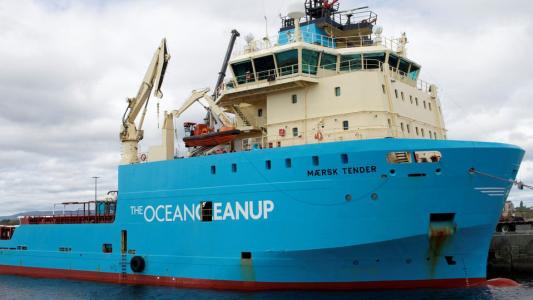 The Ocean Cleanup‘s latest attempt to clean plastic from the Northern Pacific has proven to be unimpressive. After two offshore supply vessels, donated by Maersk, towed a 520-meter wide boom for 120 hours, they succeeded in collecting around 8 tonnes of floating plastic, or roughly the equivalent to a single load of a standard garbage truck.
The Ocean Cleanup‘s latest attempt to clean plastic from the Northern Pacific has proven to be unimpressive. After two offshore supply vessels, donated by Maersk, towed a 520-meter wide boom for 120 hours, they succeeded in collecting around 8 tonnes of floating plastic, or roughly the equivalent to a single load of a standard garbage truck.
Around 2014, the media became enthralled with a story of a 19-year-old Dutch engineer named Boyan Slat, who claimed to have designed a boom system that would clean up half the plastic in the Great Pacific garbage patch within a decade. Many engineers and oceanographers doubted that the scheme would work, but the media and several large corporate sponsors bought into the grand vision. The title of an article in the magazine Fast Money from 2017, Boy Genius Boyan Slat’s Giant Ocean Cleanup Machine Is Real, reflects the enthusiasm for the project.
Slat founded the non-profit, The Ocean Cleanup, and has raised over $50 million to test his designs. Slat has been notably successful in attracting funding from corporations including Coca-Cola and in-kind donations from Maersk.
While Slat has been successful in funding his project, so far his designs have not succeeded in collecting much plastic. In 2018, The Ocean Cleanup tested a 600-meter-long prototype boom system, nicknamed Wilson, that was intended to drift in thin the Pacific Ocean. Unfortunately, the boom didn’t collect much plastic and soon broke apart in the ocean waves.
Rather than drifting collecting plastic passively, The Ocean Cleanup’s new design, nicknamed Jenny, is meant to be towed by two offshore supply vessels, essentially trawling for floating plastic.
Reuters reports that The Ocean Cleanup spokesperson Joost Dubois described the amount of plastic collected as “on the high end of our estimates” and emphasized that it was still just in the test phase.
The Ocean Cleanup hopes eventually to deploy 10 to 15 expanded-range Jennys — powered by 20 to 30 ships — to operate round the clock 365 days a year at the garbage patch. At that scale, organizers say, the effort could recover between 15,000 and 20,000 tonnes of plastic a year, though it would cost hundreds of millions of dollars.
The group regrets its reliance on ships that release climate-warming greenhouse emissions. The Ocean Cleanup is purchasing carbon credits to offset the heavy fuel use and noted that Maersk is experimenting with less-polluting biofuels. “Preferably we would have done something without any carbon footprint,” Dubois said.
A study published in Nature in 2018 suggests that the Great Pacific Garbage Patch is growing “exponentially” and now spans roughly 617,763 square miles (1.6 million square km), or about three times the size of France. The garbage patch is an accumulation of plastic and floating debris brought together by a gyre, a circular current, in the Pacific between California and Hawaii. It is thought to be the largest ocean garbage patch on earth. According to the study, the trash is made up of 1.8 trillion pieces of plastic weighing nearly 90,000 tons.
The study determined that at least 46% of the floating debris are fishing nets and related cordage. These “ghost nets” are a major threat to fish populations around the world and pose an entirely different set of challenges in any potential cleanup. The Ocean Cleanup’s Jenny booms do not appear designed to retrieve ghost nets.
In 2018, we posted about the sailing cargo vessel Kwai, backed by the non-profit Ocean Voyages Institute, that collected 170 tons of plastic waste and ghost nets from the Pacific during July and August of that year.
Miriam Goldstein, director of ocean policy at the Center for American Progress think tank commented on The Ocean Cleanup’s approach to the problem of ocean plastics. “By far the best way to help the ocean is to prevent plastic from getting in the ocean in the first place, Once plastic has gotten into the open ocean, it becomes very expensive and fossil-fuel intensive to get it back out again.”
Thanks to Virginia Jones for contributing to this post.

At least they tried, fairplay to them. As a research and development engineer I can tell you that we learn more from what didn’t work rather than what did and we can apply it to finding solutions.
Once again we are attacking the effect and not the cause. Perhaps we should move the efforts nearer to the source and put the nets across all the rivers that run into the Pacific. And every other ocean for that matter.